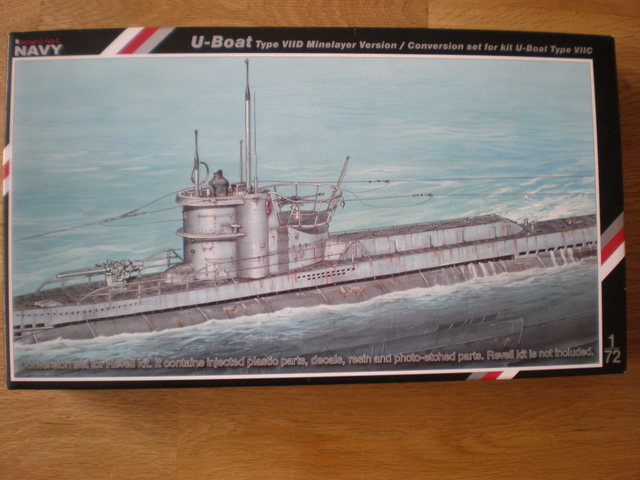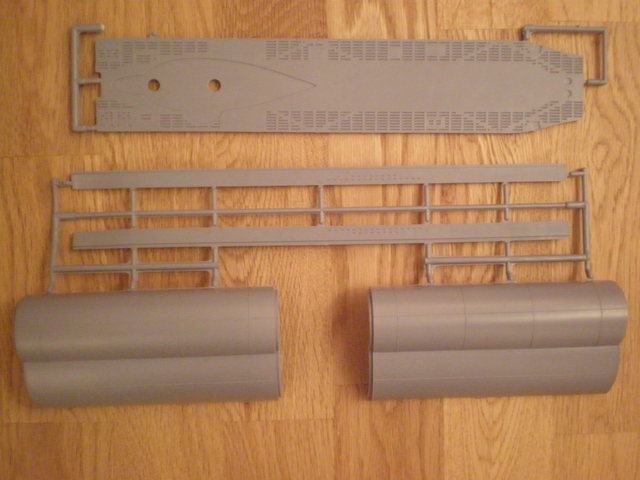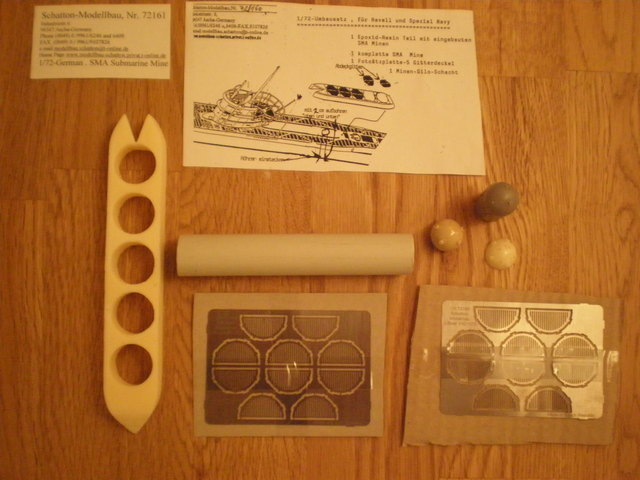Hi.
This is Martin from Germany and I want to show you some pics of my WIP of my Type VIID-Submarine U-213 in 1/72, which I have almost finished.
I choose this boat, because it was the first Type VIID and the Commander, Olt. z.S. Amelung von Varendorff, was 2.WO on U-47 at his raid to Scapa Flow.
--------------------------------------------------------------------------------------------------------------------------------------------------------------------
General information about the U- Boat Type VII D / classificationIn addition to those already in service underground mine-layers of the type XB German engineers designed on the basis of the draft VII-C boat , the minelayer version VII D. The draft VII C was doing an additional approximately ten meters long mine section directly behind the command center complements . In this section , five vertical shafts were to receive three modified SMA / hawser mines that could be notched at diving trip to the bottom. In addition, the boats carried an increased amount of fuel to increase the route with them. However, the boats were not as efficient as a conventional VII C, because in spite of increased dimensions, the propulsion system remained unchanged. A total of only six boats, built U -213 to U -218 , on the Friedrich Krupp Germania Werft AG in Kiel (factory 583 ) . The need of the German navy in special underground mine -layers was limited, because all German submarines could place especially for them developed hawser and magnetic mines. These were thrown by compressed air from the 53.3 cm torpedo tubes. Normally, could (depending on type ) instead of a spare torpedoes 2-3 mines are carried. As a result, could be carried on board , instead of the 26 to 39 torpedoes mines a normal VII C boat . The mines of the D VII were open and thus constantly flooded. The laying of the mines could be obeyed from the boat personnel properly themselves.
Of the six built VII D- boats survived only one , U -218 , the war , which was later fitted with a snorkel system and a second anti-aircraft platform , which two of the five mine shafts hidden (and thus probably useless made ) .
The U- boat Type VII F has yet been developed on the basis of the VIID. This version was built primarily as a torpedo carrier. In contrast to the Type VII D loading capacity was created instead of the mine hatches. Since the acquisition of torpedoes by another boat the emergence of both units required and this was extremely risky in the Atlantic by the danger of air-raids , the boats were mainly used for transport between bases, especially the base of the so-called "monsoon boats" in Penang (Malaysia) used. From the Type VII F four boats were built , of which only one survived the war.
Technical Data VII D• Maximum Operating Depth: 150 m (shipyard stated)
• Maximum quantity of fuel : 169.4 tons
• Lowest Fast Even time : 30 seconds
• Engine : diesel engines: 2 Engine (MAN , Krupp )
E- machine : 2 units (various makes)
• Maximum output of the machines :
surfaced : 3200 hp
immersed : 750 hp
• Displacement:
about 965 tons of water , under water 1,080 tons, a total of 1,285 tons
• Length: Overall, 76.9 m, 59.8 m pressure body
• Width: Overall, 6.38 m, 4.7 m pressure body
• Draft: 5.01 m
• Height: 9.7 m
• Speed: 16.7 kn on water , under water 7.3 kn
• Range: 11,200 nautical miles over water ( 20,700 km ) at 10 kn ,
under water 69 nautical miles (130 km ) at 4 kn
• Torpedo Armament: 4 torpedo tubes at the bow, 1 stern torpedo tube
• carried torpedoes : 12 to 14 ( the sources differ here )
• carried mines in the shafts : 15
• Flak - Armament: up to 1942 1 × 2cm Flak , later 2 × 2cm Flak + 1 × 3.7 cm Flak
• Other: at the time of entry into VIID boats was on all boats still
the deck gun mounted, the net cutter was gone
The story of U -213U -213 was the first boat of the type VII D ordered 16 February 1940 by the Navy procurement office, layed down on 1. October 1940 on the Friedrich Krupp Germania Werft AG , Kiel (factory 583 ) Yard No. 645 and was completed on 24 July 1941. On 30 August 1941 the 28-year old Oberleutnant zur See Amelung of Varendorff get the command of the boat. From Varendorff came from an old German noble family and was born on 20 December 1913 in Kiel. His entry into the Kriegsmarine was on 5 April 1935 , he belongs like Günther Reeder (U -214 ), Kurt Reichenbach-Klinke (U -217 ) and Reinhard " Teddy" Suhren (U -564 ) to Crew 35. Von Varendorff was promoted to Lieutenant on 1 October 1939 and served as the 2. WO under Günther Prien in U- 47 during its attack on the British Home Fleet at Scapa Flow in October 1939.
U -213 was ordered for crew training to the 5. U- Boat Flotilla (Kiel) and remained there until 31 December 1941. On 1 January 1942 it becomes a front boat of the 1. U- Boat Flotilla (Brest). On 1 May 1942 it was ordered to the 9. U- Boat Flotilla (Brest) as a front boat and remained in this until his demise.
The tower - Maling of U -213 was the " Snorting Bull" - the symbol which OLt. Engelbert Endrass, 1. WO on U-47 , later commander of U -46 and U -567 and winner of the Knight's Cross with Oak Leaves , had drawn on the return trip from Scapa Flow on the tower of the boat. The idea for this Maling came Endrass since the bull symbolized not stubbornness , but the determination of Prien for the implementation of this bold enterprise. Endrass drew the Maling to the tower of U -47 , while Prien early in the morning was still asleep , von Varendorff stood on the bridge so secure that Prien did not notice something. They wanted surprise Prien - and they succeeded . The Maling justified then known to the nickname Prien - " The Bull of Scapa Flow" .
The Snorting Bull later became the symbol of 7. U- Flotilla (St. Nazaire ) and was also used by other boats. It is obvious that von Varendorff take the Snorting Bull on the tower of his boat because of his attachment to Prien and U-47.
U -213 completed three patrols during its service life, which all led it into the North Atlantic . The boat sank or damaged no enemy ships during its period of use.
Unternehmen "Grete"On 25 April 1942 took U -213 on his second patrol after a short stop in Lorient, where a guest was taken on board , by the Bay of Biscay course on the North American east coast.
After a three-week crossing over the sea the boat reached the coast of Canada near a small uninhabited area called Great Salmon River. This was about 10 miles east of the village of St. Martins, on the north coast of the Bay of Fundy in New Brunswick. On 14 May 1942 the crew of U -213 brought its "Passenger ", Lt. Alfred Langbein, an agent of the German "Abwehr" on land. U-213 was able to remove from the coast unnoticed, after the crew members returned. Langbein's mission was to inform the German naval command by radio about expiring convoys from Halifax, one of the greatest Allied ports in the North Atlantic.
In order to camouflage themselves Langbein should output as " Alfred Haskins " from Toronto during his stay in Canada. The agent buried after landing the radio transmitter near its landing site , went to the small village of St. Martins , bought food in a local shop and then hitched a ride to Saint John , where he later take a train to Montreal.
A short time later Langbein moved to Ottawa and lived from the money, which he get to fulfill his mission by the German secret service. In September 1944, he turned to the Canadian authorities and introduced himself as a german. Various sources claim that Langbein gives up because he ran out of money. Langbein was not punished by the Canadians as a spy, but was taken prisoner of war. He was released after the war.
U -213 get back home after a unsuccessful patrol on 20. June 1942 in Lorient and hauled a few days later at the home port of Brest.
Wolf Pack OperationsU -213 took part on three "Wolf Pack" operations during the war:
1. Operation "Schlei" 1. February to 12. February 1942 together with U -136 , U -404 , U -578 , U -591 , U -656 and U -753 , a total of 3 sinkings with 5,878 GRT by U -136 (Zimmermann)
2. Operation "Westwall" , participation of 2 March to 12 March 1942 together with U-87 , U -135 , U -553 , U -569 , U -701 , U -752 and U -753 , a total of 5 sinkings with 2,594 GRT by U -701 ( sword ) and U -569 ( Hinsch )
3. Operation "Pfadfinder" , participation of 21. May to 27. May 1942 together with U-135 , U-404 , U-432 , U-455 , U-566 , U-578 and U-653 , a total of 10,724 GRT with two sinkings by U-432 ( Schultze ) and U-578 ( Rehwinkel ) .
U -213 was discovered on 7 February 1942 by the escort of the convoy ON- 63, on which it was operating during start-up and attacked. The boat was forced to abort the attack and for diving and was light damaged portside by depth charges in the subsequent persecution . However, U-213 was able to escape his pursuers .
On 15. May 1942, one day after landing the agent Langbein at the Canadian coast, U -213 was surfaced in foggy weather in the Gulf of Maine by a U.S. destroyer on patrol. U-213 was slightly damaged in the subsequent water bomb persecution , but escaped.
The last rideOn 23. July 1942 U-213 starts from Brest to his last patrol. The brief was to operate on the convoy OS-35, which had left Liverpool with 51 ships on 21 July 1942 with destination Freetown. On 31. July 1942 the boat was discovered southeast of the Azores in position 36 ° 45'N 22 ° 50'W from a Geleitsicherungszug, consisting of the British corvettes and frigates ("Sloops" ) HMS Erne ( Black Swan class), HMS Rochester (Shoreham / Falmouth - class) and HMS Sandwich ( Bridgewater - class). It was damaged by depth charges and sunk. All 50 crew members were killed. By fished up debris and body parts, the British could be sure that they had sunk U -213.
--------------------------------------------------------------------------------------------------------------------------------------------------------------------
For the build I used the Revell Kit 05015, the Conversion Set from Special Navy, the Eduard PE-Set, the Conversion Set for open Mine-hatches from Robert Schatton, Barrels and antennas from Schatton, the CMK Turret-Set and some scratch-building work.
All flood-holes and -vents were opened by the way.
Painting was realised with Revell-Acryics and artist oil-colors.




























Hier dann die Schnitt-Bilder und weitere Bilder vom Bau, Flutschlitze öffnen, schnibbeln, schneiden, spachteln:




















Sources for my research were:
www.wikipedia.org www.uboat.netwww.convoyweb.org.ukwww.naval-history.netwww.u-boot-archiv.deKöhl/Niestle: U-Boottyp VII C - Vom Original zum Modell
Alexandre Korganoff: Günther Prien – Mit U47 gegen Scapa Flow